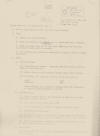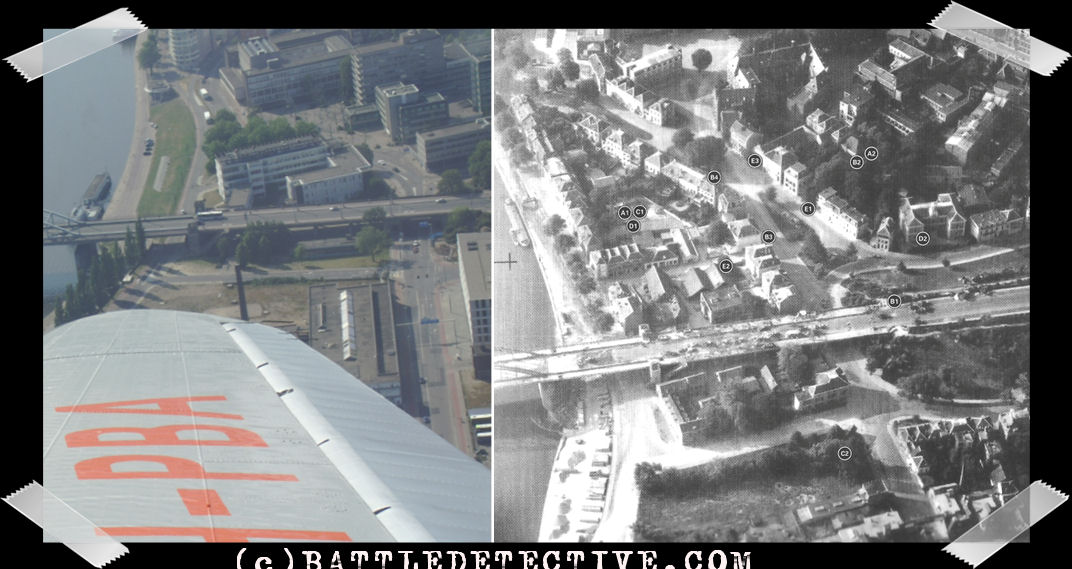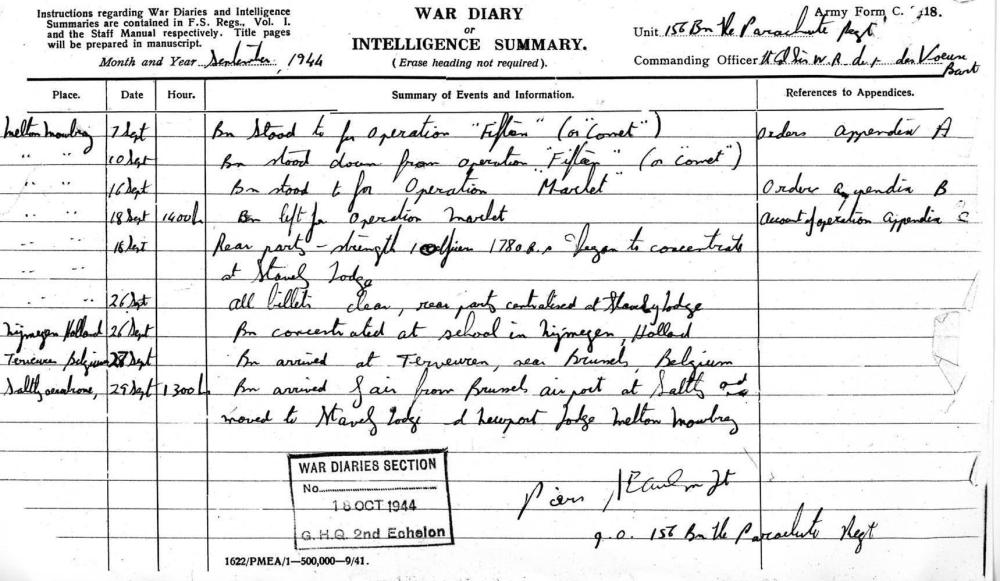|

File No.:
Battle Study # 21
Title: Cancelled Airborne
Operations prior to "Market Garden"
Investigation made at:
Ohio University Library, Athens,
Ohio & the Netherlands Institute for
Military History, Van Alkemade
Barracks, The Hague, The Netherlands
Period Covered: September
1944
Date: March to June
2011
Case Classification:
Discovery in historical archives of
documents indicating two additional
planned, and cancelled, Allied
airborne operations prior to "Market
Garden"
Case Status: Case
Open
REASON FOR INVESTIGATION:
From numerous publications we
have thus far understood that the
plan for the Allied operation
"Market Garden" in September 1944
was preceded by a certain number of
codenamed operations
with the operations named
"Transfigure", "Boxer", "Axe head",
"Linnet" (variations I and II),
"Infatuate"
and "Comet" preceding "Market
Garden". We have now found two
different sources which may indicate
that in the turbulent period of
September 1944 even more plans have
been made, and cancelled, just prior
to “Market Garden; also known as the
Battle of Arnhem. |
SYNOPSIS:
Prior to Operation "Market Garden",
the 1st Airborne Division (or for
some operations only one or more
subunits of Brigade- and
Battalion-size) has been put on
alert status for a rather large
number of different operations. Even
today it is not completely clear
exactly how many operations have
been planned and subsequently
cancelled.
In his book "Airborne Forces: Second
World War, 1939-45" (London,
Imperial War Museum, 1990 reprint),
finished in 1951, Lieutenant Colonel
T. Otway wrote the official account
of the British Airborne Forces in
the Second World War. The book
remained a 'restricted document'
until it was reprinted by the
Imperial War Museum in 1990.
We own a copy of this publication
which still bears the following
warning on its dust jacket:
|
|
 |
|
The book describes the operations of
British paratroop, glider borne, air
landing and SAS unit in a very
detailed manner.
It also lists names of planned and
cancelled operations with their
codenames and operational issues.
Operation "Market Garden", in
contrast to the operational plan
preceding it, "Comet" designed the
deployment of not only the 1st
Airborne Division but most of the
units comprising the newly formed
First Allied Airborne Army and was
planned only 7 days after the
original "D-Day" of "Comet".
This short planning period implies
that operation plans were drawn up
in quick succession at the time.
Until recently there were no clues
of historical accounts failing to
mention any of the plans cancelled
before "Market Garden" finally went
ahead. But now this agency has
discovered evidence suggesting that
perhaps two different operational
plans were cancelled after operation
"Comet" and before "Market":
operations "Clover" and "Sixteen".
|
|
|
|
EXHIBITS:
Operation "Sixteen"
Ohio University in Athens owns the
collection "Cornelius Ryan
Collection of World War II Papers".
It contains all research material
for Ryan's best-selling books The
Longest Day (Operation OVERLORD,
Normandy, France, June 6, 1944); A
Bridge Too Far (Operation
MARKET-GARDEN, Holland, September
17-26, 1944); and, The Last Battle
(the capture of Berlin, Germany,
April 15-May 10, 1945).
The Cornelius Ryan archives came to
Ohio University through the efforts
of former war correspondent John
Wilhelm, past director of the
university's E. W. Scripps School of
Journalism and founding dean of the
College of Communication. The
archive was acquired by the
university from Ryan's widow,
Kathryn Morgan Ryan, in 1981.
Through the efforts of library
curator Doug McCabe we obtained the
operational plans for "Comet".
We requested these for studying
purposes and stumbled upon a single,
loose, undated page named "Outline
Plan" which is captioned: OPERATION
SIXTEEN. |
|
(Click on the
thumbnail to enlarge)
 |
|
"SIXTEEN" had been scratched and
"Market" was added in handwriting.
On the same page the paragraph
describing the original role of the
US 101st Airborne Division in the
original Operation "Sixteen", was
renamed to the 82nd Airborne
Division with a simple scratch and a
scribbled '82'.
Because the paragraph "Own Troops"
on this page describes British units
and speaks of "the
Commander-in-Chief 21 Army Group
(Field Marshall Bernard L.
Montgomery)" it is possible that
"Sixteen" was the codename of the
forerunner of what was later
sub-named Operation "Garden"; the
role of the ground forces of British
2nd Army in "Market-Garden". |
JULY 18th, 2014 UPDATE
We have recently come across a
document in which verbally given
orders by Lieutenant-General F.A.M.
Browning of the First Allied
Airborne Army of September 10th,
1944 for Operation Market Garden are
confirmed.
The document has the some content as
the document described but in a
different lay-out and different
handwriting changing the operation's
name from "Sixteen" to "Market".
|
|
(Click on the
thumbnail to enlarge)

(For the whole
document, click thumbnail)
 |
Operation "Clover"
For a different case than this one, we were
visiting the archives of the
Netherlands Institute for Military
History (NIMH) in the Van Alkemade
Barracks in The Hague, The
Netherlands in March 2011.
We had requested several archived
documents and among these we found
seven (7) documents captioned "CLOVER"
which again had been scratched to be
renamed "Comet" in handwriting.
These documents are: |
|
(Click on the
thumbnails to enlarge) |
|
 |
1)
Air Movement Table – Form
"A", Annex No. 2 to F.O No.
6, 1st Lift – "D" Day,
dated
7 SEP 1944 of Headquarters
52nd Troop Carrier Wing,
Page No. 1 |
|
 |
2)
Air Movement Table – Form
"A", Annex No. 2 to F.O No.
6, 2nd Lift – "D" Day,
dated
7 SEP 1944 of Headquarters
52nd Troop Carrier Wing,
Page No. 2 |
|
 |
3)
Air Movement Table – Form "A",
Annex No. 2 to F.O. (Field Order)
No. 6, 1st Lift – D+1,
dated 7 SEP
1944 of Headquarters 52nd Troop
Carrier Wing, Page No. 3 |
|
 |
4)
Signal Annex No. 5 to Field Order
No 6 HQ, 52ND TROOP CARR WING, dated
7 SEP 1944 |
|
 |
5)
Signal Annex No. 5 to Field Order
No 6 (cont'd) |
|
 |
6)
Appendix No. 1 to Signal Annex
No. 5 to Field Order "CLOVER"
COMET
Schedule of Navigational Aids |
|
 |
7)
Appendix No. 2 to Signal Annex
No. 5 to Field Order "CLOVER"
COMETGEE Coordinates |
|
|
The United States Army Air Corps'
52nd Troop Carrier Wing had
apparently codenamed their previous
field order "Clover" but was
subsequently given the codename
"Comet". The details of the
operation stayed the same as in
"Clover".
The documents all refer to Drop- and
Landing zones of the units in the
operational plan for "Comet" in the
edition of
7 SEP 1944 which is a clue that
"Clover" was the codename of a
forerunner of "Comet".
In Operation "Market-Garden" the
52nd Troop Carrier Wing carried
elements of the British 1st Airborne
Division into battle. |
Flight in 52nd Troop Carrier Wing
"Vomit Comet"
On Saturday May 23rd 2011,
battledetectives
boarded a 67 year old airplane, a
former C47 "Skytrain" and member of
the 52nd, built in 1944, serving in
the US Army Air Forces with serial
number 42-100971. This plane is said
to have flown sorties in light of
"Market Garden" and is now featured
in Royal Dutch Airline colors and
the DC3 "Dakota" luxurious passenger
variety. We attended the
Friends of the Airborne Museum
Battlefield Tour "Arnhem from
Above".
Some paratroopers did not bother the
C47 or DC3 designations and
nicknamed the Skytrain or Dakota
"Vomit Comet".
Battle Detective Tom knows why.
Out
of 4 flights in a plane of this
type, this was his second motion sickness
free flight.
Excitement conquered
nausea from turbulence on this hot
May-day. |
Click to enlarge)

Unused (empty)
motion sickness bag |
|
Our airborne battlefield tour took
off from Teuge Airport near
Apeldoorn and brought us over the
Veluwe National Park, the Drop- and
Landing Zones on Ginkel Heath, the
towns of Renkum, Wolfsheze and
Oosterbeek and the city of Arnhem.
Afterwards the crew chief gave us
the flight schedule: |
 |
EXHIBITS:
We took these photographs: |
|
(Click on the
thumbnails to enlarge)
_small.jpg)
.jpg)
_small.jpg)
Boarding (doubling as
General Taylor of the 101st Airborne
prior to "Market") |
|
(Click on the
thumbnails to enlarge)
_small.jpg)
_small.jpg)
_small.jpg)
Veluwe and Ginkel
Heath |
|
(Click on the
thumbnails to enlarge)
_small.jpg)
_small.jpg) _small.jpg)
Airborne Cemetery
Oosterbeek |
|
(Click on the
thumbnails to enlarge)
_small.jpg)
_small.jpg)
_small.jpg)
_small.jpg)
_small.jpg)
_small.jpg)
_small.jpg)
_small.jpg)
Arnhem and John Frost
Bridge |
(Click to enlarge) |
|
Arnhem, Holland, September 18th
1944
This comparison
shows the main objective of
Operation "Market-Garden" just after
the Nazi attempt to regain the
bridge. Destroyed vehicles are
scattered on the northern bridge
ramp. |
(Click to enlarge) |
|
Arnhem, Holland, September 18th
1944
This
photograph shows the carnage done by
Colonel John Frost's 2nd Para
Battalion to the Nazi attempt to
attempt to recapture the bridge.
Numbers on the houses show various
positions of Frost's men and are added on photo by
Dutch historian Karel Margry. |
|
On this beautiful May-day the
meadows on the Southern bank of the
river Rhine river looked like a
suitable Drop Zone for landing a few
sticks of paratroopers. Perhaps the
reason for not using this terrain
for "Market Garden" is material for
anther Battle Study. Keep monitoring
this website. |
CONCLUSION:
Without a doubt Operation "Market
Garden" was planned in a hurry. The
Allied forces had their enemy on the
run. Plan after plan was made to
"end the war in '44". Their designs
became obsolete when the ink on
which these plans were printed was
still wet. Grounds of designated
Drop- and Landing Zones were
captured before the paratroops
ordered to take them could even
board their "Vomit Comets".
This may explain, for example, why
no research was done into the
suitability of the meadows South of
Arnhem bridge and the choice was
made to land the 1st British
Airborne Division 8 miles from their
main objective.
Otway wrote on page 214 of his
"Airborne Forces: Second World War,
1939-45": |
"45. When 'Linnett II' was
cancelled 1 Airborne Division
was ordered to plan operation
'Comet', the object of which was
to secure the bridges over the
River Rhine from Arnhem to
Wesel, in order to facilitate
the advance on the
Ruhr basin from the north,
but only 1 Airborne Division and
1 Polish Parachute Brigade were
to be used. Division
Headquarters, 1 Polish Parachute
Brigade and 1 Air-landing
Brigade were to land at
Nijmegen, 1 Polish Parachute
Brigade at Arnhem and 4th
Parachute Brigade at Grave. 'D'
day was to be 10th September and
take off at 0600 hours, but at
0200 hours on 10th September,
senior officers at division
headquarters were awakened and
told that the operation was
cancelled. By 1500 hours that
same day the Commander 1
Airborne Division, Major-General
R. E. Urquhart and his staff had
received fresh instructions and
were at work planning the
Division's part in operation
'Market', which was to take
place a week later. In the
'Market' plan two airborne
divisions out of the three to be
used, plus a parachute brigade,
were allocated to the tasks
given above which a few hours
before had been considered
within the powers of one
division and one parachute
brigade."
|
Neither the plans of operation
"Clover" nor "Sixteen" are
mentioned.
We think that these codenames have
just drowned in the turmoil of
freshly drawn-up and immediately
cancelled plans in the pre-"Market
Garden" era.
We at least have registered their
existence, how short-lived these
plans may have been.
|
DECEMBER 31st, 2022 UPDATE
On the
Pegasus Archive website we found
the 1 Airborne Division's War Diary
which is filed in the British
National Archives under catalogue
reference WO 171/392 and 393.
On the website the contents of these
documents are transcribed. In the
first part of September 1944 we
read:
"2nd September 1944 Place: Moor
Park
Operation 'LINNET' cancelled.
6th September 1944 Place: Moor Park
1 Airborne Div Operation Instruction
No.8 issued - Confirmatory Notes on
Div Commander's Verbal Notes.
Amendment No.1 to 1 Airborne Div
Operation Instruction No.8 issued -
Operation 'FIFTEEN' (Seize
and hold bridges over the MAAS
CANAL, RIVER WAAL and NEDER RIJN).
Operation 'FIFTEEN' - 1
Airborne Div Planning Intelligence
Summary No.1 issued. Summary of
Aircraft Lifts issued. Coup de Main
Party - Air Movement Table.
7th September 1944 Place: Moor Park
0120 - Operation 'FIFTEEN'
to be known as Operation 'COMET'.
Operation 'COMET' - 1 Airborne Div
Planning Intelligence Summary No.2
issued.
8th September 1944 Place: Moor Park
Operation 'COMET' - 1 Airborne Div
Planning Intelligence Summary No.3
issued.
10th September 1944 Place: Moor Park
1 Airborne Div Intelligence Summary
No.22 with references to Operation
'COMET' issued.
1540 - Operation 'COMET' cancelled
and transit camps unsealed.
12th September 1944 Place: Moor Park
Operation 'MARKET' (ARNHEM) - 1
Airborne Div Operation Instruction
No.9 issued - Confirmatory Notes on
GOC's Verbal Orders. Operation
'MARKET' - 1 Airborne Div Planning
Intelligence Summary No.1 issued." |
|
JULY 10th, 2023 UPDATE On
the
Paradata website we found the
Intelligence Summary of 156
Battalion the Parachute Regiment for
September 1944. It also describes
standing to for Operation "Fifteen"
(or "Comet") on the 7th of that
month and standing down from it on
the 10th: |
|
(click to enlarge)
 |
CONCLUSION
From these War Diaries written
under the supervision of the
Division's Commanding Officer Maj-Gen
R. E. Urquhart DSO and of the 156th
Bn The Parachute Regiment we can conclude
that Operation "FIFTEEN" was the
"working title" for Operation
"Comet" until the security situation
and the planning phase allowed the
real name to be disclosed. Operation
"SIXTEEN" was therefore the working
title for Operation "Market", the
sixteenth operation planned by the
British First Airborne Division
since 6JUN1944.
|
|
Back to Battle Studies
 |













